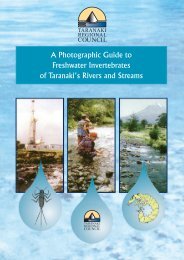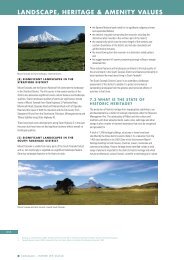Annual report 2006-2007 - Taranaki Regional Council
Annual report 2006-2007 - Taranaki Regional Council
Annual report 2006-2007 - Taranaki Regional Council
Create successful ePaper yourself
Turn your PDF publications into a flip-book with our unique Google optimized e-Paper software.
taxa was found at site F, slightly above the historical median (Table 3). This richness was<br />
only slightly less than the number of taxa recorded at the nearest upstream site (E) (Figure<br />
2). Three ‘highly sensitive’ taxa were present (indicative of good water quality conditions),<br />
one of which was abundant (Deleatidium mayfly), along with five ‘moderately sensitive’ taxa<br />
(Coloburiscus and Austroclima mayflies, elmid beetles, Archichauliodes dobsonfly and<br />
Aphrophila cranefly); and four ‘tolerant’ taxa (very abundant Aoteapsyche caddisfly, and<br />
abundant orthoclad, Maoridiamesa and Austrosimulium midges). These characteristic taxa<br />
were similar to community compositions at upstream sites and there were very few<br />
significant differences within individual taxon abundances between the adjacent sites E and<br />
F as emphasised by the similar SQMCIS scores (Table 2).<br />
MCI value<br />
Number of taxa and MCI values in the Kahouri Stream u/s of Stratford<br />
CC pow er station (KHI000457)<br />
140<br />
120<br />
100<br />
80<br />
60<br />
40<br />
20<br />
0<br />
Jan-88<br />
Jan-89<br />
Jan-90<br />
Jan-91<br />
Jan-92<br />
Jan-93<br />
Jan-94<br />
Jan-95<br />
Jan-96<br />
Jan-97<br />
Jan-98<br />
Jan-99<br />
Jan-00<br />
Jan-01<br />
Jan-02<br />
Jan-03<br />
Jan-04<br />
Jan-05<br />
Jan-06<br />
Jan-07<br />
MCI value M edian M CI to date<br />
No. of taxa M edian no. of taxa to date<br />
Figure 8 Number of taxa and MCI values in the Kahouri Stream at site F (KHI000457)<br />
Similar to the communities of upstream sites, the community at site F had a moderately high<br />
proportion of ‘sensitive’ taxa (62% of total richness), which was reflected in the MCI score of<br />
96 units, similar to the long term median score (Table 3). The MCI score was slightly (but not<br />
significantly) lower than that recorded at site E upstream, reflective of the loss of two ‘highly<br />
sensitive’ taxa in the community at this site upstream of the Stratford Power Station.<br />
Small differences in community composition between adjacent sites E and F were illustrated<br />
by the small difference in SQMCIs scores which were within 0.5 unit. The score at site F (5.5<br />
units) was significantly higher than the median score recorded by the eight most recent<br />
surveys at this site (Table 2). The MCI and SQMCIs both indicated that there was no real<br />
downstream deterioration of macroinvertebrate communities in the reach of the Kahouri<br />
Stream between site E and F, which is often demonstrated in catchments due to non-point<br />
sources of nutrients (TRC, 1999). This was demonstrated by the median SQMCIs (Figure 3)<br />
which decreased in a downstream direction. This may reflect the generally intact and good<br />
quality riparian vegetation in the Kahouri Stream which may limit effects during summer<br />
low flow conditions.<br />
Site G: Kahouri Stream (KHI000465)<br />
This partially shaded site located downstream of the Stratford Power Station discharges was<br />
about 1 km downstream of site F, and downstream of discharges from the power station. A<br />
community richness of 22 taxa found at this site was very similar to the historical median<br />
(Table 3). Two ‘highly sensitive’ taxa were recorded, reflecting good water quality<br />
conditions, and one of these taxa was abundant (Deleatidium mayfly). The community was<br />
also characterised by eight ‘moderately sensitive’ taxa (Coloburiscus and Austroclima<br />
11<br />
70<br />
60<br />
50<br />
40<br />
30<br />
20<br />
10<br />
0<br />
No. of taxa














